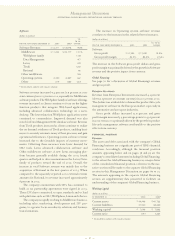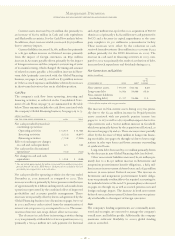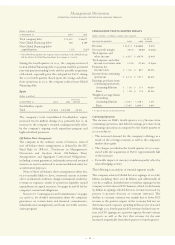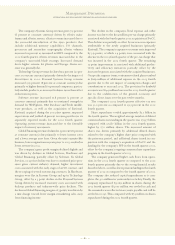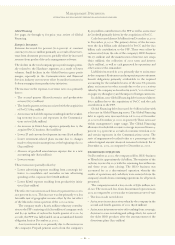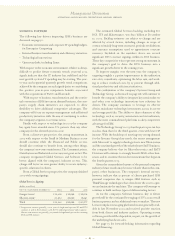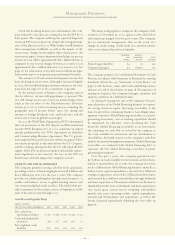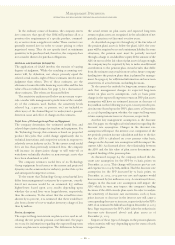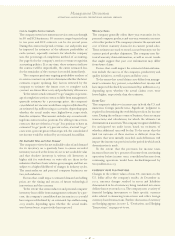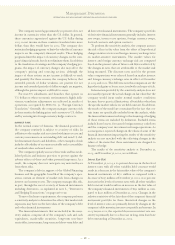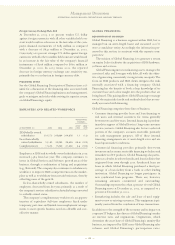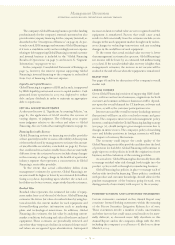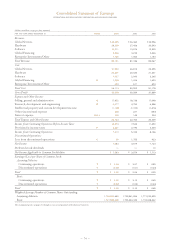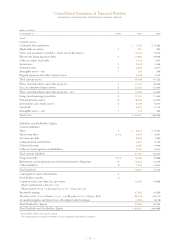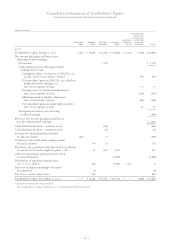IBM 2003 Annual Report Download - page 68
Download and view the complete annual report
Please find page 68 of the 2003 IBM annual report below. You can navigate through the pages in the report by either clicking on the pages listed below, or by using the keyword search tool below to find specific information within the annual report.
66
In the ordinary course of business, the company enters
into contracts that specify that IBM will purchase all or a
portion of its requirements of a specific product, commod-
ity, or service from a supplier or vendor. These contracts are
generally entered into in order to secure pricing or other
negotiated terms. They do not specify fixed or minimum
quantities to be purchased and, therefore, the company does
not consider them to be purchase obligations.
CRITICAL ACCOUNTING ESTIMATES
The application of GAAP involves the exercise of varying
degrees of judgment. While the resulting accounting esti-
mates will, by definition, not always precisely equal the
related actual results, eight of these estimates involve more
judgment than others. Two of these estimates are the
allowance for uncollectible financing receivables and the fair
value of lease residual values. See page 73 for a discussion of
these estimates. The others are discussed below.
The sensitivity analyses used below are not meant to pro-
vide a reader with management’s predictions of the variabil-
ity of the estimates used. Rather, the sensitivity levels
selected (e.g., 5 percent, 10 percent, etc.) are included to
allow users of the Annual Report to understand a general-
direction cause and effect of changes in the estimates.
Useful Lives of Technology Group Plant and Equipment
The company determines the estimated useful lives and
related depreciation charges for its plant and equipment. For
the Technology Group, this estimate is based on projected
product life-cycles that could change significantly due to
technical innovations and competitor actions in response to
relatively severe industry cycles. To the extent actual useful
lives are less than previously estimated lives, the company
will increase its depreciation charge or will write-off or
writedown technically obsolete or non-strategic assets that
have been abandoned or sold.
The company estimates useful lives of its Technology
Group equipment by reference to the current and projected
dynamics in the semiconductor industry, product life-cycles
and anticipated competitor actions.
To the extent that Technology Group actual useful lives
differ from management’s estimates by 10 percent, consoli-
dated net income would be an estimated $57 million
higher/lower based upon 2003 results depending upon
whether the actual lives were longer/shorter, respectively,
than the estimates. To the extent that the actual lives were
shorter by 10 percent, it is estimated that there would have
also been a lower-of-cost-or-market inventory charge of less
than $5 million.
Pension Assumptions
The expected long-term return on plan assets is used in cal-
culating the net periodic pension cost/(income). See pages
110 to 115 for information regarding the expected long-term
return on plan assets assumption. The differences between
the actual return on plan assets and expected long-term
return on plan assets are recognized in the calculation of net
periodic pension cost/(income) over five years.
As described on pages 110 through 115, if the fair value of
the pension plan’s assets is below the plan’s ABO, the com-
pany will be required to record a minimum liability. In some
situations, the pension asset must be partially reversed
through a charge to stockholders’ equity. If the amount of the
ABO in excess of the fair value of plan assets is large enough,
the company may be required, by law, to make an additional
contribution to the pension plan. Actual results that differ
from the estimates may result in more or less future company
funding into the pension plans than is planned by manage-
ment. See page 65 for additional information and near-term
sensitivities of actual returns on funding decisions.
To the extent the outlook for long-term returns changes
such that management changes its expected long-term
return on plan assets assumptions, each 50 basis point
change in the expected long-term return on PPP plan assets
assumption will have an estimated increase or decrease of
$225 million on the following year’s pre-tax net periodic pen-
sion income (based upon the PPP’s plan assets at December
31, 2003) depending upon whether the expected long-term
return assumption increases or decreases, respectively.
Another key management assumption is the discount
rate. See pages 110 through 115 for information regarding the
discount rate assumption. Changes in the discount rate
assumption will impact the interest cost component of the
net periodic pension income calculation and due to the fact
that the ABO is calculated on a net present value basis,
changes in the discount rate assumption will also impact the
current ABO. As discussed above, the relationship between
the ABO and the fair value of plan assets determines any
required funding of the pension plans.
As discussed on page 64, the company reduced the dis-
count rate assumption for the PPP by 75 basis points on
December 31, 2003. This change will increase pre-tax cost
and expense in 2004 by $184 million. Had the discount rate
assumption for the PPP increased by 75 basis points on
December 31, 2003, 2004 pre-tax cost and expense would
have increased by $21 million in 2004. As mentioned above,
changes in the discount rate assumption will impact the
ABO which, in turn, may impact the company’s funding
decisions if the ABO exceeds plan assets. In order to analyze
the sensitivity of discount rate movements, each 25 basis
point increase or decrease in the interest rate will cause a
corresponding decrease or increase, respectively, in the PPP’s
ABO of an estimated $1 billion based upon December 31, 2003
data. Page 113 presents the PPP’s ABO (after the reduction in
discount rate discussed above) and plan assets as of
December 31, 2003.
Impacts of these types of changes on the pension plans in
other countries will vary depending upon the status of each
respective plan.
Management Discussion
INTERNATIONAL BUSINESS MACHINES CORPORATION AND SUBSIDIARY COMPANIES



